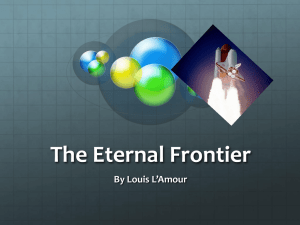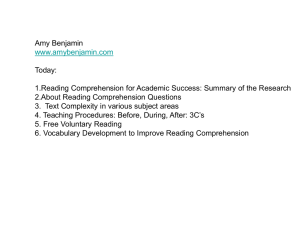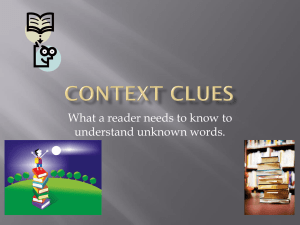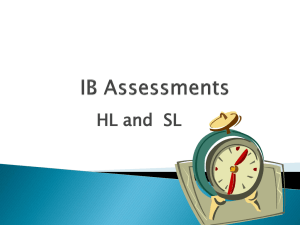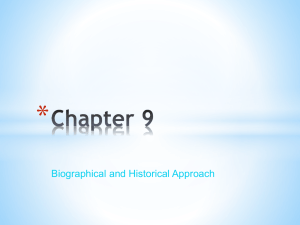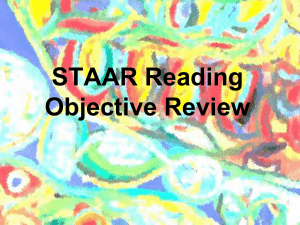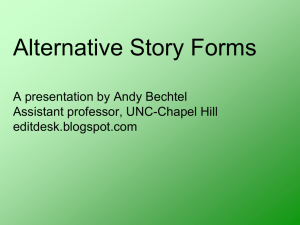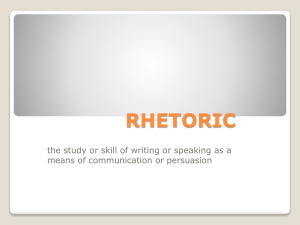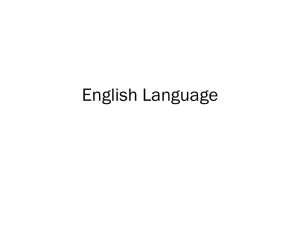Compositional Risks - Burnet Middle School
advertisement
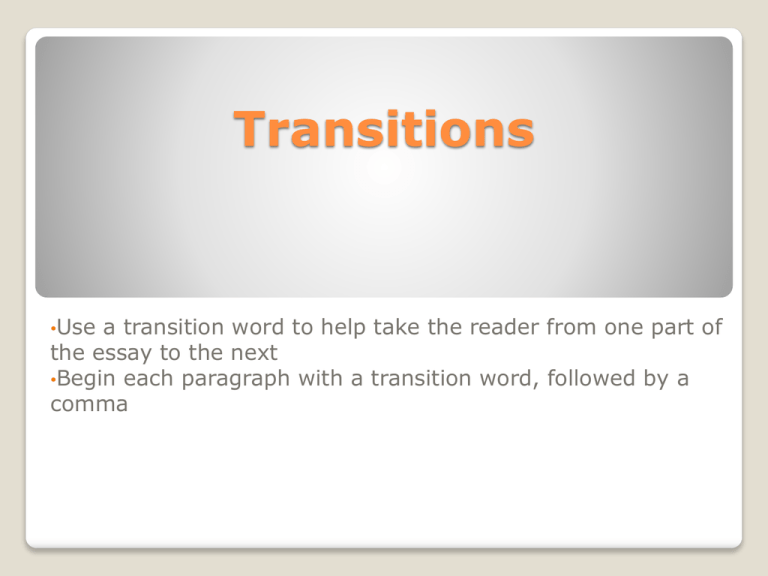
Transitions •Use a transition word to help take the reader from one part of the essay to the next •Begin each paragraph with a transition word, followed by a comma Transitions continued… Addition: also, again, as well as, besides, coupled with, furthermore, in addition, likewise, moreover, similarly Consequence: accordingly, as a result, consequently, for this reason, for this purpose, hence, otherwise, so then, subsequently, therefore, thus, thereupon, wherefore Generalizing: as a rule, as usual, for the most part, generally, generally speaking, ordinarily, usually Exemplifying: chiefly, especially, for instance, in particular, markedly, namely, particularly, including, specifically, such as Illustration: as an illustration, for instance, for one thing, illustrated with, as an example, in this case Emphasis: above all, chiefly, with attention to, especially, particularly, singularly Similarity: comparatively, coupled with, correspondingly, identically, likewise, similar, moreover, together with Exception: aside from, barring, besides, except, excepting, excluding, exclusive of, other than, outside of, save Restatement: in essence, in other words, namely, that is, that is to say, in short, in belief, to put differently Transitions continued… Contrast/Comparison: contrast, by the same token, conversely, instead, likewise, on one hand, on the other hand, on the contrary, rather, similarly, yet, but, however, still, nevertheless, in contrast Sequence (use in topic sentences): at first, first of all, to begin with, in the first place, at the same time, for now, for the time being, the next step, in time, in turn, later on, meanwhile, next, then, soon, later, while, earlier, simultaneously, afterward, in conclusion, with this in mind Summarizing (use in closing sentences): after all, all in all, all things considered, briefly, by and large, in any case, in any event, in brief, in conclusion, on the whole, in short, in summary, in the final analysis, in the long run, on balance, to sum up, to summarize, finally Direction: here, there, over there, beyond, nearly, opposite, under, above, to the left, to the right, in the distance Compositional Risks A “compositional risk” refers to an attempt by an author to do something interesting, engaging, and unusual with his/her writing. Successful compositional risks make your writing unique in a good way; unsuccessful compositional risks make it unique in a bad way. It is a “risk” because your attempt might make the writing great, but if it doesn’t work, it could make the writing terrible. Rhetorical Questions Use In: Essays Rhetorical questions are questions that a speaker or writer asks an audience as a way to get the audience thinking about a specific topic in a specific way. When you ask a rhetorical question, you are not expecting a reply. Rhetorical questions are phrased so that most sensible people will arrive at a specific answer, an answer that the writer already knows before he or she even asks the question. Using this strategy serves as a way for the writer to make a point about a topic and to get the reader to agree with the author’s opinion right away. Some things to avoid: DO NOT “talk” to the reader through your rhetorical questions. DO NOT use the word “you” in your rhetorical questions. DO NOT make your rhetorical questions too simplistic (example, “Should people be encouraged to kick puppies?”) Figurative Language Use in: Persuasive, Speculative, and Explanatory Essays Note: Make sure your figurative language makes sense, and that the reader will understand the figurative reference. Common Types of Figurative Language Used in Essays: Simile: a comparison using like or as. This tool allows the writer to create interesting and unusual comparisons that might help the reader see the topic in a new way. Metaphor: a comparison without the use of like or as. Like the simile, a well written metaphor allows the writer to create interesting and unusual comparisons that might help the reader see the topic in a new way. Onomatopoeia: The use of words that imitate the sounds associated with the objects or actions they refer to. This device words well in speculative writing, but should be used sparingly in persuasive and explanatory writing. Personification: giving human traits to objects that are not human. This device also works best in speculative writing. Alliteration: the repetition of an initial consonant sounds. This device should be used in speculative writing and can be used VERY SPARINGLY in persuasive and explanatory essays – it can be very effective when emphasizing a point. ADVANCED VOCABULARY Used in: Speculative, Persuasive and Explanatory Essays Note: Be sure to use the words correctly and remember good writing uses the fewest possible words to make a point. Try to incorporate words that most effectively convey your meaning. Be specific (example, saying something is blue might work, saying it is aqua might work better.) Be careful not to just throw in “fancy” words especially if you are not 100% certain that you know what they mean. It is better to stick with simpler words you know well then to use a word incorrectly just to impress the reader. Try to incorporate some of the words of the week into your writing. VARIED SENTENCE STRUCTURE Use in: Speculative, Persuasive, and Explanatory Essays Note: incorrect grammar, punctuation, or sentence structure can cost you points. Using many different types and kinds of writing demonstrates to the reader that you know the rules of writing. Use the four different kinds of sentences in your essays: declarative, imperative, interrogatory, and exclamatory. Write sentences of varied length. Short sentences make the reader’s eyes stop frequently, suggesting stop and go movement in the writing. Medium length sentences are good for providing information. Using varied sentence lengths allows you to demonstrate your command of punctuation. VIVID DESCRIPTION Use in: speculative, persuasive, and explanatory essays. Note: It can be hard to find the balance between “not enough” and “too much” description. Any time you write, you should always try to include clear, easy to understand descriptions that let the reader see exactly what you are talking about. You can’t describe every item in detail, you have to pick and choose the important parts of your writing and carefully select the parts that will have the most impact for the reader and which are most important to your story or essay. Consider using figurative language in your descriptions When describing physical objects or situations, you should think about including the following: color, size, number, sound, mood/emotion. – see below for more details. Color: Don't just say "green", be specific about what shade or hue, and feel free to get into some similes and metaphors or other comparisons to help the reader picture it exactly as you see it in your head. Example: The leaves of the tree in spring were glittering emeralds, shimmering in the light; in places, the green was as dark as a shadow at midnight, while in others, it sparkled like LED beacons. Size: As with color, be specific and give easy-to-relate-to comparisons that allow the reader to get a strong mental image of what you're describing. Example: Instead of saying, "The horse was big"... My father, a tall man, was dwarfed by the horse; his head barely reached the beast's shoulders. It had to be nearly ten feet tall from the ground to the tip of its ears. VIVID DESCRIPTION continued… Number: This requires walking a fine line; you don't have to say, "There were 4,692 flies buzzing around the rotten fruit," but you also want to say more than, "There were a few flies" if there were a large number of them. You can use descriptions of the situation and comparisons to help the reader get an idea of the number without actually having to specify a single number (besides, who knows what 4,692 flies actually looks like?). Example: So many flies were buzzing around and landing on the rotten fruit that, if I hadn't known what I was looking at, I would have thought some sort of noisy smoke cloud as large as a compact car was sitting before me, making it difficult to see past the spot. Sound: Nowhere is comparison and analogy more important than when discussing sound. There are few words that can accurately capture volume, and people have a very wide range of tolerances for sound that one person's "loud" is another person's "inaudible". Example: Instead of saying, "The music was loud"... The music coming out of the speakers caused Jim's insides to shake and rumble. Items on his shelves were bouncing in time to the beat, getting ready to jump to the floor, which itself was vibrating. Mood/emotion: The word "happy" is rather weak, descriptively; it doesn't really provide much in the way of intensity. A person who finds a penny might be happy, as might a person who wins ten million dollars in the lottery, but they're probably not feeling the same level or degree of that emotion. Many emotive words are similar. Again, the use of comparison can help quantify for the reader the type and intensity of emotion. Example: Instead of saying, "Marco was very sad"... Marco felt himself being pulled down in a whirlpool of depression; he could feel it sucking him deeper and deeper into darkness, choking off whatever breaths of happiness he tried to draw to help sustain him. The deeper he went, the harder it pulled at him, until all he could feel was the crushing, numbing pain.
